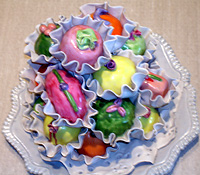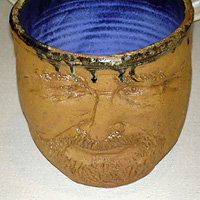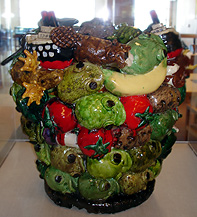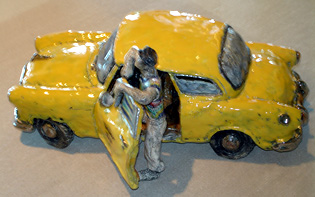
"Breaking with Tradition: The Legacy of Robert Arneson," ceramic sculpture from the Paula and Ross Turk Collection, is on display at UCSF's Kalmanovitz Library on the Parnassus campus through December 16.
Arneson, who lived from 1930 to 1992, is internationally recognized for his innovative approach to ceramics, establishing clay as a major sculptural medium and using humor to comment on contemporary cultural and political issues.
The exhibition includes art works by Arneson and nine of his former students in a range of styles that represent the major movements in ceramics from "Funk" to "Super-Object" to "Postmodern," according to Lynne Baer, art consultant to the Chancellor's Advisory Committee on Art, Honors and Recognition, which arranged for the temporary exhibit.
A professor of art at the University of California, Davis from 1962 until his death, Arneson left a legacy of work that transforms traditional forms and subject matter. He encouraged his students to experiment and explore new ideas, which often are whimsical.
 |
| "Broccoli Head," by Peter Vandenberge |
The Turk collection features a few works with the face of Arneson himself - an image that the campus community may be familiar with, given that his profile appears in various angles on pillars in Saunders Court. His face appears on a stoneware pot aptly titled "Bob Pot," his 1972 rendition of folk art, and on the 1978 piece called "Smorgi-Bob Plate," in which the artist is wearing a chef's hat and stands before a large array of food. A larger, freestanding work of the same subject matter is in the permanent collection of the San Francisco Museum of Modern Art.
Among other featured works are:
- • "Broccoli Head," 1973, a terra-cotta and glaze
figure that satirizes the vegetarian food movement of the 1970s, by Dutch-born
Peter Vandenberge;
- • "Transitional Piece," 1980, a vase composed
of planes, boats and cars as well as frogs and other animals by American artist
David Gilhooly;
- • "Steve Kaltenbach and his Yellow Flab Rambler,"
1967, by the Australian artist Margaret Dodd;
- • "John's Other Boots," 1972, a pair of realistic-looking
boots made of stoneware and leather for the shoelaces, by the late American
artist Marilyn Levine; and
- • "Assorted Colours on Paper Cases," 1974, which
looks like pastel-colored pastries made of porcelain, by American artist Sandra
Shannonhouse.
 |
| "Assorted Colours on Paper Cases," by Sandra Shannonhouse. |
Arneson's Life, Legacy
Born and raised in Benicia, CA, Arneson graduated with a BA degree in arts education from the California College of Arts and Crafts in Oakland in 1954. He received an MFA degree in ceramics from Mills College also in Oakland in 1958, when he studied under Antonio Prieto, renowned for his uniquely glazed classic vessels. While Arneson learned the technical aspects of ceramics from Prieto, he was inspired by the groundbreaking work of Peter Voulkos, who taught at UC Berkeley and created large-scale abstract expressionist sculptures out of clay in the late 1950s.
 |
| "Bob Pot," by Robert Arneson. |
In 1962, Arneson launched a ceramic program in the newly formed Art Department at UC Davis. Arneson developed the program based on his own evolving philosophy of using clay to comment on broader artistic, social and cultural issues, according to Baer. His innovative approach to his own work created an environment that encouraged experimentation, attracting bright and creative students looking to break with tradition, she noted.
 |
| "Transitional Piece," by David Gilhooly. |
"The legacy of Robert Arneson is one of freedom and experimentation," Baer says. "His influence, as seen in the works in this exhibition, can be detected in all the major movements in ceramics -- from Funk to Super-Object to Postmodern --that have made California and, in particular, UC Davis, the recognized center for innovation in clay."
The Paula and Ross Turk Collection is considered to be one of the best collections of abstract and figurative ceramics in the country. Ross Turk began collecting more than 30 years ago, when he became intrigued with what he saw as the breaking by Arneson and his students with the traditional ways of creating in clay.
 |
| "Steve Kaltenbach and his Yellow Flab Rambler," by Margaret Dodd |





